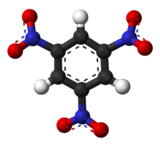1,3,5-Trinitrobenzene
A pale yellow solid, the compound is highly explosive.[2][3] 1,3,5-Trinitrobenzene forms charge-transfer complexes with electron-rich arenes.[4] Trinitrobenzene is more explosive than TNT, but more expensive.[2] It is primarily used as a high explosive compound for commercial mining and military applications.It has also been used as a narrow-range pH indicator, an agent to vulcanize natural rubber, and a mediating agent to mediate the synthesis of other explosive compounds.


Preferred IUPAC nameCAS NumberChemSpiderECHA InfoCardPubChemUN numberCompTox DashboardSMILESChemical formulaMolar massDensityMelting pointBoiling pointSolubility in waterMagnetic susceptibilityNFPA 704standard statetrinitrobenzenedecarboxylation2,4,6-trinitrobenzoic acidcharge-transfer complexesphloroglucinol1,2,3-TrinitrobenzeneTNT equivalentRE factorGESTIS Substance DatabaseInstitute for Occupational Safety and HealthUllmann's Encyclopedia of Industrial Chemistry